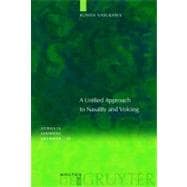
Note: Supplemental materials are not guaranteed with Rental or Used book purchases.
Purchase Benefits
Looking to rent a book? Rent A Unified Approach to Nasality And Voicing [ISBN: 9783110184815] for the semester, quarter, and short term or search our site for other textbooks by Nasukawa, Kuniya. Renting a textbook can save you up to 90% from the cost of buying.
| Abstract | vii | ||||
| Acknowledgements | ix | ||||
| Abbreviations and symbols | xv | ||||
| Chapter 1 Nasal-voice affinities | |||||
|
1 | (1) | |||
|
2 | (8) | |||
|
2 | (4) | |||
|
2 | (2) | |||
|
4 | (2) | |||
|
6 | (7) | |||
|
6 | (2) | |||
|
8 | (1) | |||
|
9 | (1) | |||
|
10 | (103) | |||
| Chapter 2 Typological aspects of nasality and voicing | |||||
|
113 | ||||
|
13 | (7) | |||
|
13 | (2) | |||
|
15 | (5) | |||
|
20 | (6) | |||
|
20 | (1) | |||
|
21 | (1) | |||
|
21 | (1) | |||
|
22 | (2) | |||
|
24 | (2) | |||
|
26 | (1) | |||
|
27 | (5) | |||
|
27 | (3) | |||
|
30 | (2) | |||
|
32 | (3) | |||
| Chapter 3 The melodic architecture of nasality, voicing and prenasality | |||||
|
35 | (1) | |||
|
35 | (2) | |||
|
37 | (4) | |||
|
41 | (3) | |||
|
41 | (1) | |||
|
41 | (1) | |||
|
42 | (2) | |||
|
44 | (3) | |||
|
47 | (3) | |||
|
50 | (3) | |||
| Chapter 4 An integrated approach to nasality and long-lead voicing | |||||
|
53 | (3) | |||
|
56 | (5) | |||
|
56 | (1) | |||
|
56 | (4) | |||
|
60 | (1) | |||
|
61 | (14) | |||
|
61 | (3) | |||
|
64 | (4) | |||
|
68 | (4) | |||
|
72 | (2) | |||
|
74 | (1) | |||
|
75 | (2) | |||
|
77 | (12) | |||
|
77 | (1) | |||
|
78 | (4) | |||
|
82 | (7) | |||
|
89 | (5) | |||
|
89 | (1) | |||
|
90 | (4) | |||
|
94 | (1) | |||
| Chapter 5 Prenasalisation and nasalisation of voiced obstruents | |||||
|
95 | (1) | |||
|
96 | (2) | |||
|
96 | (2) | |||
|
98 | (1) | |||
|
98 | (5) | |||
|
103 | (4) | |||
|
103 | (1) | |||
|
103 | (2) | |||
|
105 | (2) | |||
|
107 | (3) | |||
|
107 | (1) | |||
|
108 | (2) | |||
|
110 | (1) | |||
| Chapter 6 Assimilatory processes involving nasality and voicing | |||||
|
111 | (1) | |||
|
112 | (3) | |||
|
115 | (8) | |||
|
115 | (3) | |||
|
118 | (3) | |||
|
121 | (2) | |||
|
123 | (16) | |||
|
123 | (3) | |||
|
126 | (3) | |||
|
129 | (3) | |||
|
132 | (3) | |||
|
135 | (4) | |||
|
139 | (4) | |||
|
143 | (1) | |||
|
143 | (4) | |||
| Chapter 7 Conclusion | |||||
|
147 | (3) | |||
|
150 | (3) | |||
| Notes | 153 | (10) | |||
| References | 163 | (16) | |||
| Language index | 179 | (2) | |||
| Subject index | 181 | (6) | |||
| Author index | 187 |
The New copy of this book will include any supplemental materials advertised. Please check the title of the book to determine if it should include any access cards, study guides, lab manuals, CDs, etc.
The Used, Rental and eBook copies of this book are not guaranteed to include any supplemental materials. Typically, only the book itself is included. This is true even if the title states it includes any access cards, study guides, lab manuals, CDs, etc.